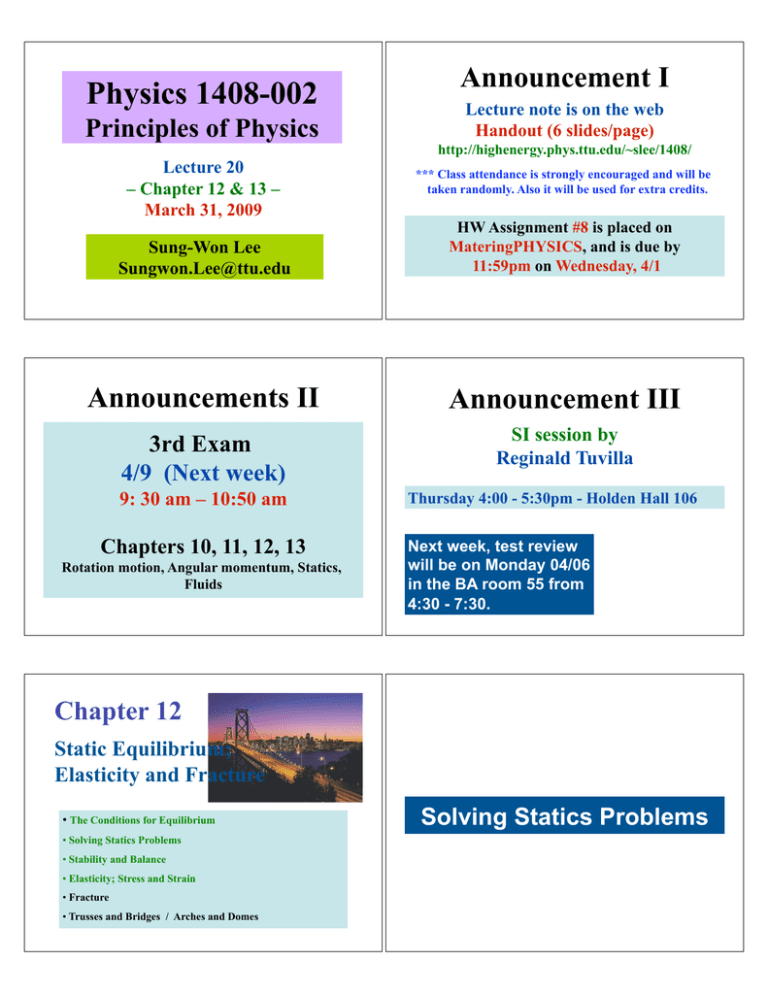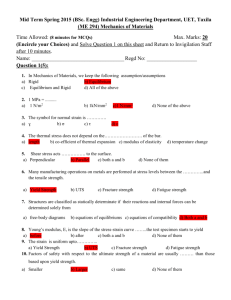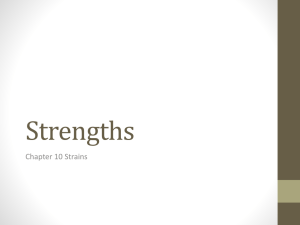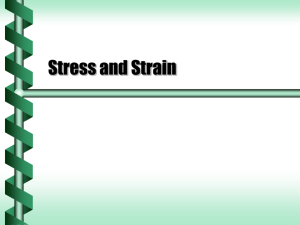Physics Lecture Notes: Statics, Elasticity, Fluids
advertisement

Physics 1408-002 Principles of Physics Lecture 20 – Chapter 12 & 13 – March 31, 2009 Announcement I Lecture note is on the web Handout (6 slides/page) http://highenergy.phys.ttu.edu/~slee/1408/ *** Class attendance is strongly encouraged and will be taken randomly. Also it will be used for extra credits. Sung-Won Lee Sungwon.Lee@ttu.edu HW Assignment #8 is placed on MateringPHYSICS, and is due by 11:59pm on Wednesday, 4/1 Announcements II Announcement III 3rd Exam 4/9 (Next week) SI session by Reginald Tuvilla 9: 30 am – 10:50 am Chapters 10, 11, 12, 13 Rotation motion, Angular momentum, Statics, Fluids Thursday 4:00 - 5:30pm - Holden Hall 106 Next week, test review will be on Monday 04/06 in the BA room 55 from 4:30 - 7:30. Chapter 12 Static Equilibrium; Elasticity and Fracture •!The Conditions for Equilibrium •!Solving Statics Problems •!Stability and Balance •!Elasticity; Stress and Strain •!Fracture •!Trusses and Bridges / Arches and Domes Solving Statics Problems Hanging Lamp Hanging Lamp •! A lamp of mass M hangs from the end of plank of mass m and length L. One end of the plank is held to a wall by a hinge, and the other end is supported by a massless string that makes an angle with the plank. (The hinge supplies a force to hold the end of the plank in place.) –!What is the tension in the string? –!What are the forces supplied by the hinge on the plank? •! First use the fact that !! m !" hinge L M in both x and y directions: x: T cos ! + Fx = 0 y: T sin ! + Fy - Mg - mg = 0 " y x ! Now use ! = 0 in the z direction. "!If we choose the rotation axis to be through the hinge then the hinge forces Fx and Fy will not enter into the torque equation: L LMg + mg - LT sin ! = 0 2 Hanging Lamp m L/2 M Fy !" L/2 Fx mg Mg 12-4 Elasticity; Stress and Strain Stress is defined as the force per unit area. (F/A) •! So we have three equations and three unknowns:" ! T cos ! + Fx = 0 T sin ! + Fy - Mg - mg = 0 LMg + ! !F = 0 Strain is defined as the ratio of the change in length to the original length. (#l/l0) y L mg - LT sin ! = 0 2 x Therefore, the elastic modulus (E) is equal to the stress divided by the strain: which we can solve to find: m% " m$ ! !$ M + ' g #" M + &% g # 2& ˆ 2 Fx = i T = tan ( sin ' 1 Fy = mg ĵ 2 m L/2 M Fy !" L/2 Fx mg Mg Young’s Modulus: Elasticity in Length •! Tensile stress is the ratio of the external force (F) to cross-sectional area (A) Young’s Modulus A mass M hangs from a steel wire of cross sectional area A and length L and Young’s modulus Y. By what #L amount does the wire stretch? –! For both tension and compression •! The elastic modulus is called Young’s modulus Y= •! SI units of stress: Pascals, [Pa] F tensile stress F Lo = A = tensile strain !L A !L Lo Answer: stress = F/A= Mg/A, so –! 1 Pa = 1 N/m2 •! The tensile strain is the ratio of F the change in length to tensile stress F Lo Y= = A = the original length !L tensile strain A !L Lo #L M #L = (1/Y)(FL/A) = (1/Y)(MgL/A) Note: Y(steel) = 200*109 N/m2 12-4 Elasticity; Stress and Strain 12-4 Elasticity; Stress and Strain Example 12-7: Tension in piano wire. A 1.60-m-long steel piano wire has a diameter of 0.20 cm. How great is the tension in the wire if it stretches 0.25 cm when tightened? 12-4 Elasticity; Stress and Strain 12-4 Elasticity; Stress and Strain Compressional stress is exactly the opposite of tensional stress. These columns are under compression. The three types of stress for rigid objects: This Greek temple, in Agrigento, Sicily, built 2500 years ago, shows the post-and-beam construction. The columns are under compression. 12-4 Elasticity; Stress and Strain The shear strain, where G is the shear modulus: The fatter book (a) shifts more than the thinner book (b) with the same applied shear force. Shear Modulus: Elasticity of Shape •! Forces may be parallel to one of the objects faces •! The stress is called a shear stress; F/A •! The shear strain is the ratio of horizontal displacement & the height of the object; #x/h F shear stress Fh GS = = A = !x shear strain A !x •! The shear modulus: G h •! A material having a large shear modulus is difficult to bend 12-4 Elasticity; Stress and Strain If an object is subjected to inward forces on all sides, its volume changes depending on its bulk modulus. This is the only deformation that applies to fluids. (see next) or Bulk Modulus: Volume Elasticity •! Bulk modulus characterizes the response of an object to uniform squeezing –! Suppose the forces are perpendicular to, and acts on, all the surfaces as when an object is immersed in a fluid •! The object undergoes a change in volume without a change in shape •! Volume stress (#P) = the ratio of the force to the surface area; This is also the Pressure •! Volume strain = Ratio of the change in volume to the original volume B= 12-5 Fracture "F volume stress A = ! "P =! "V "V volume strain V V 12-5 Fracture If the stress on an object is too great, the object will fracture. The ultimate strengths of materials under tensile stress, compression stress, and shear stress have been measured. When designing a structure, it is a good idea to keep anticipated stresses less than 1/3 to 1/10 of the ultimate strength. 12-5 Fracture Example 12-8: Breaking the piano wire. A steel piano wire is 1.60 m long with a diameter of 0.20 cm. Approximately what tension force would break it? 12-5 Fracture A horizontal beam will be under both tensile and compressive stress due to its own weight. Therefore, it must be made of a material that is strong under both compression and tension. 12-5 Fracture A uniform pine beam, 3.6 m long and 9.5 cm x 14 cm in cross section, rests on two supports near its ends, as shown. The beam’s mass is 25 kg and two vertical roof supports rest on it, each one-third of the way from the ends. What maximum load force FL can each of the roof supports exert without shearing the pine beam at its supports? Use a safety factor of 5.0. 12-6 Trusses and Bridges One way to span a wide space is to use a truss—a framework of rods or struts joined at their ends into triangles. A truss bridge A roof truss 12-6 Trusses and Bridges On a real bridge, the load will not be centered. The maximum load rating for a bridge must take this into account. A uniform pine beam, 3.6 m long and 9.5 cm x 14 cm in cross section, rests on two supports near its ends, as shown. The beam’s mass is 25 kg and two vertical roof supports rest on it, each one-third of the way from the ends. What maximum load force FL can each of the roof supports exert without shearing the pine beam at its supports? Use a safety factor of 5.0. 12-6 Trusses and Bridges Each truss member is under either tension or compression; if the mass is small, these forces act along the strut. (a) Each massless rod of a truss is assumed to be under tension or compression. (b) The two equal and opposite forces must be along the same line or a net torque would exist. (c) Real struts have mass, so the forces F1 and F2 at the joints do not act precisely along the strut. (d) Vector diagram of part (c). 12-6 Trusses and Bridges For larger bridges, trusses are too heavy. Suspension bridges are one solution; the roadway is suspended from towers by closely spaced vertical wires. (a) Truss with truck of mass m at center of strut AC. (b) Forces on strut AC. Suspension bridges (Brooklyn and Manhattan bridges, NY). 12-7: Arches and Domes 12-7: Arches and Domes The stones or bricks in a round arch are mainly under compression, which tends to strengthen the structure. The Romans developed the semicircular arch about 2000 years ago. This allowed wider spans than could be built with stone or brick slabs. 12-7: Arches and Domes Unfortunately, the horizontal forces required for a semicircular arch can become quite large. The pointed arch was an improvement, but still needed external supports, or “flying buttresses.” 12-7: Arches and Domes A dome is similar to an arch, but spans a two-dimensional space. 12-7: Arches and Domes The pointed arches require considerably less horizontal force than a round arch. Chapter 13 Fluids •!Density and Specific Gravity •!Pressure in Fluids •!Atmospheric Pressure and Gauge Pressure & Measurement •!Pascal’s Principle •!Buoyancy and Archimedes’ Principle •!Fluids in Motion; Flow Rate and the Equation of Continuity •!Bernoulli’s Equation & its Applications! Fluids 13-1 Phases of Matter The three common phases of matter are solid, liquid, and gas. •!A solid has a definite shape and size. •!A liquid has a fixed volume but can be any shape •!A gas can be any shape and also can be easily compressed. Liquids and gases both flow, and are called fluids. •! A fluid is a collection of molecules that are randomly arranged and held together by weak forces and by forces exerted by the walls of a container. •! Both liquids and gases are fluids. Statics & Dynamics with Fluids •! Fluid Statics –! Describes fluids at rest. •! Fluid Dynamics –! Describes fluids in motion. •! The same physical principles that have applied to statics and dynamics will also apply to fluids. 13-2 Density & Specific Gravity The density ! of a substance is its mass per unit volume: The SI unit for density: kg/m3. Density is also sometimes given 13-2 Density and Specific Gravity Example 13-1: Mass, given volume and density. What is the mass of a solid iron wrecking ball of radius 18 cm? in g/cm3; to convert g/cm3 to kg/m3, multiply by 1000. Water at 4°C has a density of 1 g/cm3 = 1000 kg/m3. The specific gravity of a substance is the ratio of its density to that of water. 13.3 Pressure •! The pressure P of the fluid at the level to which the device has been submerged is the ratio of the force to the area •! Pressure is a scalar quantity –! Because it is proportional to the magnitude of the force •! If the pressure varies over an area, evaluate dF on a surface of area(dA) as dF = P dA •! Unit of pressure: Pascal (Pa) 2 1 Pa = 1 N/m Pressure vs. Force •! Pressure is a scalar and force is a vector. •! The direction of the force producing a pressure is perpendicular to the area of interest. Measuring Pressure •! The spring is calibrated by a known force. •! The force due to the fluid presses on the top of the piston and compresses the spring. •! The pressure on the piston is then measured. 13-3 Pressure in Fluids Example 13-2: Calculating pressure. The two feet of a 60-kg person cover an area of 500 cm2. Determine the pressure exerted by the two feet on the ground.







